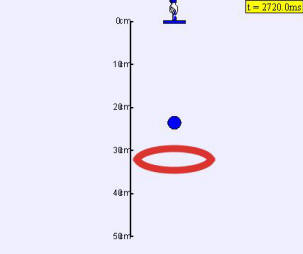

The charged ball is released and falls due to a gravitational force. The ball and the ring can be charged with a positive (colored in blue) or a negative charge.This adds an additional repulsive or attractive force between the fixed ring and the ball. The ball can be moved to a suitable height by dragging it with a mouse. The charged ring is located directly below the ball. Besides, the mass of the ball can be modified.
One can observe several scenarios:
1. The ball is heavy and starts far away from the charged ring. The ring and the ball can be equally or oppositely charged.
2. The ball is light and starts far away from the ring. The ring and the ball can be equally or oppositely charged.
3. Modify the magnitude and sign of charge on the ball and the ring and observe the effects.
4. In a certain case it is possible to trap the ball by suitably charging the ring and with suitable initial conditions (height and mass of a ball).
The Falling Ball in Electric field was motivated by the simulation example "The Falling Cup with Ball" that was created by Wolfgang Christian. Thanks to Francisco Esquembre for developing the EJS software. Author of a modified code: Dejan Križaj. All members of the Colos group (Conceptual learning of Science).
Reuse the model
You can examine and modify the physical model for this simulation if you have Ejs installed by right-clicking within the wave function plot and selecting "Open Ejs Model" from the pop-up menu. As a part of the code was reused it was not completely removed from the code. This makes some variables and programming in the code unnecessary.
Information about EJS is available at: <http://www.um.es/fem/Ejs/> and in the OSP comPADRE collection <http://www.compadre.org/OSP/>.